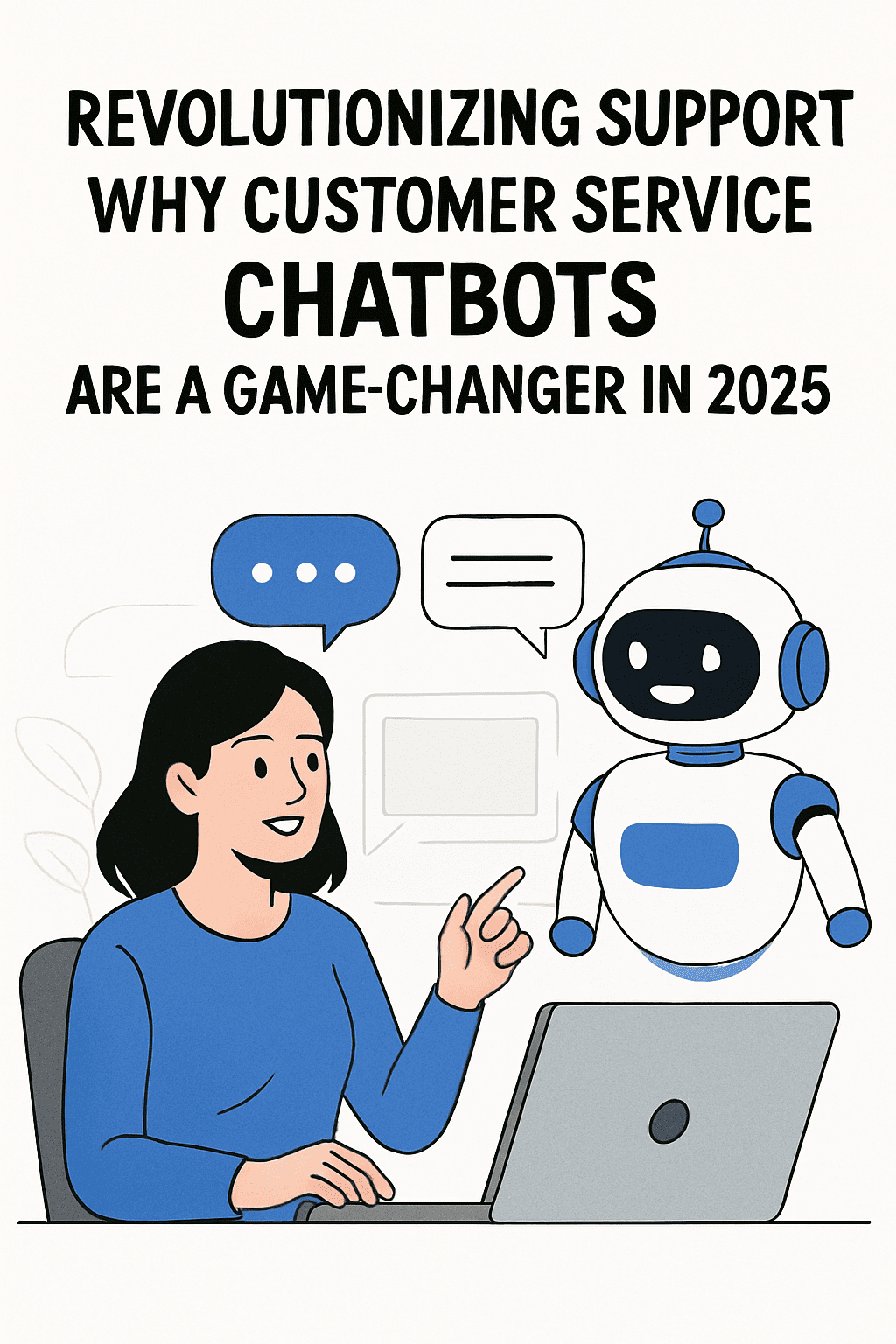The global AI in customer service market is projected to reach $35.6 billion by 2030, driven by demand for 24/7 support and personalized experiences. From chatbots resolving queries in seconds to predictive analytics anticipating customer needs, artificial intelligence (AI) is no longer a luxury—it’s a competitive necessity. In this guide, we’ll explore the benefits of AI in customer service, showcase real-world examples, and unveil the future of AI in customer service to help your business stay ahead.
Table of Contents
ToggleWhy AI in Customer Service Matters
AI transforms traditional support models by automating repetitive tasks, analyzing vast datasets, and delivering hyper-personalized interactions. Key drivers include:
Rising customer expectations for instant, seamless service.
Cost reduction: AI slashes operational expenses by up to 30%.
Scalability: Handle unlimited queries without hiring more staff.
The Rise of AI in Customer Service
Over the past decade, advancements in machine learning customer service and natural language processing have made AI tools more accessible and effective. Early chatbots could only handle simple queries, but modern AI customer support platforms can:
Understand context and sentiment
Seamlessly escalate complex issues to human agents
Provide personalized product recommendations
These capabilities enable companies to automate repetitive tasks, allowing agents to focus on high‑value interactions—and, crucially, reducing overall support costs.

Top 8 Benefits of AI in Customer Service
24/7 Availability
AI-powered chatbots like Intercom and Drift resolve 80% of routine queries instantly, even outside business hours. AI chatbots never sleep. Offering round‑the‑clock support means capturing leads and resolving issues outside regular business hours—critical for global brands serving customers across time zones.Faster Resolution Times
AI analyzes historical data to suggest solutions, cutting average handling time by 50%. AI in customer service systems can instantly route tickets, suggest answers, and even resolve issues without human intervention. Faster response times not only enhance customer satisfaction but also prevent costly escalations and repeated contacts.Personalized Experiences &Upselling
Machine learning tailors recommendations based on user behavior (e.g., Netflix’s AI-driven content suggestions). By analyzing past interactions, AI can recommend products or services with a high likelihood of conversion. This personalized upselling contributes directly to revenue, offsetting the initial investment in AI customer service solutions.Cost Efficiency
Companies using AI for customer service report 40–60% lower costs per interaction. Implementing AI chatbots and virtual assistants can handle up to 70% of routine inquiries, slashing the need for large 24/7 call center teams. For enterprises in North America and Western Europe, where hourly wages and benefits are high, these reductions translate into millions of dollars saved annually.Enhanced Agent Productivity
AI handles routine tasks, freeing agents to tackle complex issues.Data-Driven Insights
Track trends like peak demand periods or common pain points using AI analytics.Multilingual Support
Tools like Google’s Contact Center AI offer real-time translation for global audiences.Scalability and Flexibility
During peak seasons—Black Friday in the US or Boxing Day in the UK—support volumes can surge by over 200%. AI‑driven customer service automation scales effortlessly, ensuring consistent support without hiring temporary staff or paying overtime.
AI in Customer Service Examples: Real-World Success Stories
1. Amazon: Predictive Support
Amazon’s AI anticipates issues (e.g., delayed deliveries) and proactively emails customers with solutions, reducing inbound queries by 15%.
2. Zappos: AI Chatbots for Instant Support
Zappos’ chatbot handles returns, tracking, and product recommendations, boosting customer satisfaction scores (CSAT) by 20%.
3. Bank of America: Erica, the Virtual Assistant
Erica assists 37 million users with balance checks, fraud alerts, and financial advice, saving 7 million hours of manual work annually.
High‑Impact Use Cases and Examples
E‑Commerce Giant Reduces Support Costs by 30%
A leading e‑commerce retailer in the US integrated an AI customer support platform that automated order tracking and returns processing. By diverting these high‑volume tasks from human agents to AI, the company saved $4.5 million in annual support labor costs.
Telecom Major Boosts Customer Retention
In the UK, a top telecom operator implemented machine learning customer service to proactively identify dissatisfied customers. The AI flagged risk profiles based on call sentiment and usage data, prompting retention offers. This initiative reduced churn by 15%, equating to an additional £6 million in retained revenue.
Financial Services Firm Streamlines Onboarding
A Canadian bank deployed AI‑powered chatbots to guide new customers through account setup and KYC (Know Your Customer) processes. The result? A 50% faster onboarding time and a $2 million reduction in manual review costs.
Companies Using AI for Customer Service
Spotify: Recommends playlists using AI analysis of listening habits.
Starbucks: Barista chatbot processes orders via voice commands.
Sephora: Virtual Artist chatbot lets users “try on” makeup via AR.

Top AI Customer Service Tools and Platforms
| Category | Leading Solutions | Key Features |
|---|---|---|
| AI Chatbots | Ada, Intercom, LivePerson | Omnichannel support, sentiment analysis |
| Virtual Agents | IBM Watson Assistant, Google Dialogflow | Enterprise integrations, NLP accuracy |
| AI‑Powered Ticketing | Zendesk AI, Freshdesk Freddy | Automated ticket triage, response suggestions |
| Voice‑Enabled AI Assistants | Amazon Connect, Google Contact Center AI | Real‑time transcription, voice sentiment |
| Knowledge‑Base Optimization | Solvvy, Netomi | AI‑driven content suggestions, search analytics |
Best Practices for Successful Implementation
Start Small, Scale Fast: Pilot your AI use case on a single channel (e.g., website chat) before rolling out to email or voice.
Train with Quality Data: The accuracy of AI in customer service hinges on the data you feed it. Leverage historical tickets and chat logs to train models.
Maintain Human Oversight: Set clear escalation paths so AI hands off complex queries to skilled agents, ensuring no customer feels frustrated.
Monitor Performance Metrics: Track KPIs like First Response Time (FRT), Customer Satisfaction Score (CSAT), and cost per contact to measure impact.
Continuously Optimize: Use AI analytics to discover new automation opportunities—such as adding self‑service articles to your knowledge base.
Audit Existing Processes: Identify repetitive tasks (e.g., password resets) ideal for automation.
Choose the Right Tools : Chatbots: Drift, LivePerson., Analytics: Zendesk Explore, Freshdesk, Voice AI: Amazon Lex, Twilio Autopilot.
The Future of AI in Customer Service
Voice-Activated AI
Voicebots like Google Duplex will handle calls to book appointments or resolve issues autonomously.Emotional AI (Affective Computing)
Tools like Beyond Verbal analyze tone to detect frustration and route calls to human agents. Beyond sentiment, next‑gen AI will detect nuanced emotions (frustration, excitement) via text and voice, enabling hyper‑personalized responses.Predictive Customer Service
AI will forecast issues (e.g., device malfunctions) and auto-schedule repairs before customers notice.Hyper-Personalization
Expect AI to leverage IoT data (e.g., smart home devices) for context-aware support.AI-Driven Customer Journey Mapping
Platforms like Salesforce Einstein will optimize touchpoints in real time.Augmented Agents: AI assistants will work alongside human agents in real time, suggesting answers and detecting upsell opportunities during calls.
AI‑Powered Voice Biometrics: Faster and more secure authentication through voice patterns will reduce fraud and enhance customer trust.
Proactive AI Outreach: Predictive analytics will allow brands to anticipate customer issues (e.g., subscription renewals) and reach out proactively, boosting retention.

ROI of AI in Customer Service: Key Metrics
To justify investment in AI customer service solutions, businesses calculate ROI by comparing:
| Metric | Improvement with AI |
|---|---|
| Cost per interaction | 40–60% reduction |
| First-contact resolution | 35–50% increase |
| Customer satisfaction | 20–30% boost |
| Agent productivity | 50–70% gain |
By tracking these metrics, organizations consistently report millions saved annually, proving that AI is not just a trend but a strategic imperative.
How to Implement AI in Your Customer Service Strategy
Audit Existing Processes
Identify repetitive tasks (e.g., password resets) ideal for automation.Choose the Right Tools
Chatbots: Drift, LivePerson.
Analytics: Zendesk Explore, Freshdesk.
Voice AI: Amazon Lex, Twilio Autopilot.
Train AI with Quality Data
Feed historical chat logs and CRM data to refine responses.Monitor and Optimize
Use A/B testing to improve chatbot scripts and workflows.
Challenges and Solutions
Data Privacy: Comply with GDPR/CCPA using anonymized datasets.
Integration Costs: Start with low-code platforms like Tidio.
Customer Resistance: Offer seamless human handoff options.
FAQs: AI in Customer Service
Q: What are the best AI tools for customer service?
A: Top picks include Intercom (chatbots), Zoho Desk (analytics), and Ada (automation).
Q: How does AI improve customer experience?
A: Faster resolutions, personalized interactions, and 24/7 availability.
Q: Can small businesses afford AI?
A: Yes! Tools like ManyChat start at $15/month.
Conclusion
AI in customer service isn’t just a trend—it’s the future. By automating workflows, personalizing interactions, and unlocking data-driven insights, businesses can reduce costs while boosting loyalty. Start with chatbots, scale with predictive analytics, and stay ahead of competitors.






